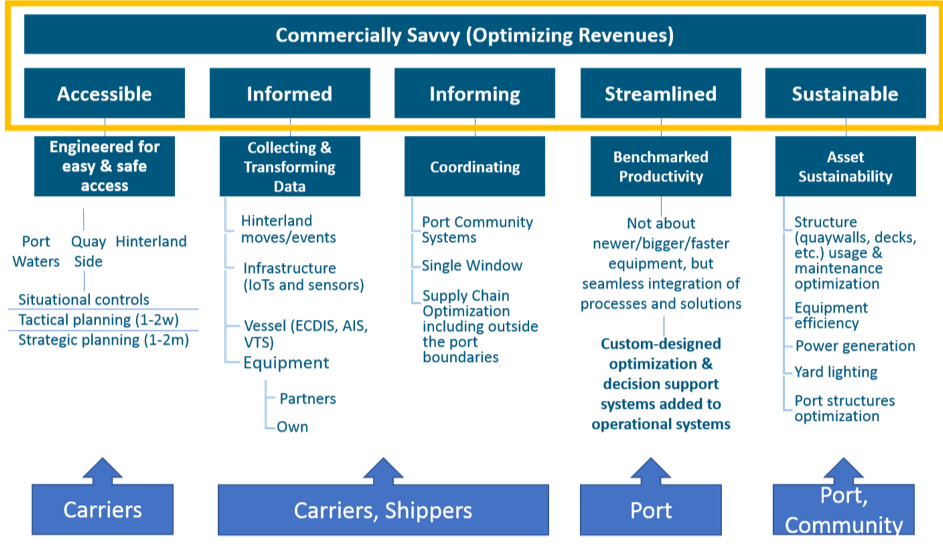 Kris Kosmala is a partner at Click & Connect, a group of expert advisers to companies engaged in all types of logistics interested in dramatically improving commercial and operational aspects of their business models, either through a reset of business processes or through implementing advanced technology solutions to better align their processes to their business objectives. Prior to this role, Kris was the director of smart port operations digital solutions at Royal HaskoningDHV, an independent international engineering and project management consultancy. We talked to Kris about the future of container logistics and the role of smart ports in the global supply chain.
Kris Kosmala is a partner at Click & Connect, a group of expert advisers to companies engaged in all types of logistics interested in dramatically improving commercial and operational aspects of their business models, either through a reset of business processes or through implementing advanced technology solutions to better align their processes to their business objectives. Prior to this role, Kris was the director of smart port operations digital solutions at Royal HaskoningDHV, an independent international engineering and project management consultancy. We talked to Kris about the future of container logistics and the role of smart ports in the global supply chain.
Can you, first of all, introduce yourself and Click & Connect to our audience?
Kris Kosmala: In the rapidly evolving world of international logistics, decisions on how to run the business under constantly changing market conditions, while leveraging avalanche of technology and commercial operations innovations are harder and harder to make. This affects business using logistics, businesses providing logistics services (including ports), and investment companies ask to finance new approaches and new generations of technology innovators. At Click & Connect we came together to provide expert advice without inbred bias affecting vendors of technology innovations across the spectrum of decisions that any of those businesses will be forced to make.
What are smart ports and why do we need them?
Kris Kosmala: Conceptually, smart ports are the ones that invest in innovative technological solutions to improve many aspects of their current operations. Unlike the preconceived notion that smart port is all about implementing new digital (software-based) solutions, smart ports place equal weight on civil engineering solutions, automation of tasks and equipment, and pure software solutions.
How would the ideal smart port ecosystem look like?
Kris Kosmala: Informed and capable of making any decision that doesn’t negatively affect any other member of the port community. As an example, the implementation of a Port Community System to allow port community members to view the statutes of various operations should be viewed as “business as usual”. A smart port builds and implements a decision-making layer on top of the PCS data that proactively advises relevant community members on what is the best action they should take, whether it regards a vessel, 3rd party vessel-related services, cargo, or cargo-related services. While all this is happening, an ideal smart port is aware in real-time of the impact it is creating on the environment in which it operates, irrespective whether we are talking about the waters or the land. It monitors itself; it can answer for any of its actions and uses gathered data on automatically improving itself in reducing the impact it has on a place in which it operates
What are the major challenges for ports when considering a digitization project?
Kris Kosmala: Lack of understanding of what it takes, how much it costs, and how long it takes before seeing benefits from their investments. Sometimes, priority is given to narrow vision urged on by a provider of particular technology or service. Unlike large enterprises which have at their disposal a team consisting of a business architect, information architect and technology architect, ports often rely on simpler and flatter organizations, leaving a lot of thinking to the technology vendors selling to them. When the implementation of those technologies takes longer than estimated or costs more than believed, those skeletal ports technology teams tend to reduce the scope to “minimum valuable project”, where that “minimum” creates so little value, that its importance to the whole ecosystem diminishes to no importance at all.

Source: A creation of Kris Kosmala
Who benefits from smart ports the most?
Kris Kosmala: This is a very interesting question and one that makes many port investments in “smart” solutions difficult to justify. The following image represents major areas of implementations that are considered smart. The blue boxes below the areas indicate major beneficiaries of port’s decisions and they illustrate the issue of gains from port’s “smart” investments accruing to parties other than the port itself.

